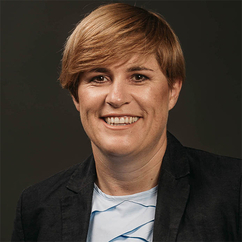IN THE SPOTLIGHT
Digital Transformation is a Test of Adaptability and Creativity
Helena Mah
According to The State of the CIO report, 40% of all technology spend goes to digital transformations. Gartner estimates that 91% of organizations are engaged in digital projects, trying to determine the right mix between digital optimization and transformation. Only 19% of them seem to be dedicated to refocusing the entire business.
The term digital transformation is overused. It needs clarification - what it is and what it isn’t?
It is not a one and done project.
It is a Big, Bold, Brave enterprise-wide process. Designed to drive change in performance, culture, and capabilities with the support of technology. Aimed to deliver business success through the development of how the company operates, understanding the potential, and how to get there. Directed toward the provision of value for the customer.
Many transformations unfortunately fail. According to McKinsey, the success rate is only ~ 30%. There can be many reasons why.
o Not aiming high enough and thinking about the full potential this change could bring or failing to recognize that it is not “impossible”.
o Falling into a trap that the main purpose is to lift the business productivity and efficiency.
o Lacking the proper buy-in from people and not connecting them to a broader purpose, missing to inspire, empower, and activate them with what is meaningful to them.
o Keeping the change in the hands of a carefully chosen few, wanting them to do more instead of democratizing change by defining smaller digestible chunks and activating a broader group of people through initiatives.
o The misaligned pairing of will and skill, forgetting about building norms, behaviors, and rewarding the right ones along the way, to sustain organizational transformation.
o Not Inspiring individuals and teams “to go places where they otherwise wouldn’t go.”
The technology has been here for some time, but there was not enough will or need to change - until today. Behavioral change is the biggest barrier to progress. What is different today? Well, we have realized now what can be done using technology.
The purpose of technology in digital transformation is to help solve business challenges toward the desired change. For some companies this can mean a new business model, for others improved customer experience or rising loyalty through engagement, technology can help to identify new revenue opportunities.
It takes time, to define the strategy and operationalize how we will get there, to select the right technology solution, and adopt the growth mindset. Change is hard. The time to start was yesterday.
Let me tell you about a recent B2B case I was leading and the key stages we went through to support growth transformation.
What was the situation?
Several company analyses were showing stagnating market traction, there was a strong decline in customer appeal and interest measured, customers shared that they see no value. Despite the purchase, the percentage of solution usage was low. There was a traditional champion approach in place, reaching only key decision-makers. The approach to the market was to sell and push the product, while customer feedback was shared through sales and disconnected systems in place. The competition was gaining share, and renewal became more demanding. Tried and done practice was very much embedded in the company culture. The internal collaboration was low and silo oriented.
We needed to re-focus our efforts and put the customer first. We didn’t understand their challenges and needs, to be able to respond and act on them. We didn’t provide value. We needed to do things differently. Why? To become relevant again and to become a part of the solution to our customers’ challenges.
We have asked ourselves - Is our digital ambition to optimize or to transform?
Optimization is less dramatic but still critical when companies use technology to simplify the things they already do and execute better – process automation, cost reduction, improved customer experience, and better decision making.
We needed to transform through the application of tools and technologies to fundamentally disrupt the industry. We required a major revamp of a company’s business model that would generate new opportunities and businesses, by not cannibalize the company’s core strengths.
An ambitious growth transformation requires proper funding. In our case, we expected investment capacity to drop between 60 – 70%, so we have been guided by a structured process of resource reallocation and reinvesting gains.
Recognizing the strategic importance of technology as a critical component of the business, not just a source of cost efficiencies but also to start laying foundations for future growth, was key in my CMO role. We needed to change how we operate, collaborate, ad value, and contribute to business performance. We also needed predictive analytics to enable better and faster decision making, by recognizing and evaluating CX patterns, to shift to data-driven campaigns with measurable outcomes allowing frequent revisions, enabling more precise scenarios over time.
How? – was significantly more challenging. When putting a Customer in the center of everything we did, marketing organization needed to move away from being a communication engine, and take the customer experience ownership, become the champion of the customer's voice.
Marketing organization was one of the very few that went across all sales and product organizations, and therefore in a unique position to influence business growth. We needed to lead the collaboration across the board and bring different stakeholders together around the knowledge of the customer. CMO as a collaborator can lead the change and drive world-class experiences, but marketing can’t do it alone. Experiences are created along the complete customer journey and brand/product lifecycle.
We needed to define smaller digestible chunks- transformation initiatives- to make the process manageable, and the team engaged behind the change. What? - was focused on the audience specifics – decision process, the industry, market dynamics, customer maturity, etc. We have immediately realized how customer situations and behaviors have changed. Suddenly we were talking to buying committees, having different roles, and different objectives. Customers were more educated and more demanding than ever before. There was also low interest in what we were trying to sell, we were expected to provide a solution to a problem and help the customer buy, through education and guidance. For the first time, we have sat behind the same table - sales, marketing, product, operations, and discussed “The customer” and the potential in front of us.
Marketing needed to become more agile. The discussion was not anymore about What marketing does, it was about transforming how the work is being done. It used to mean broad offerings and experiences across large customer segments. Now the goal was to better leverage data from customer interactions and use these insights to better meet customer needs and deliver relevant value to the segment of One.
How did we connect and scale using the technology?
Shifting to a full-scale audience-driven approach meant the integration of Mar-tech with CRM, providing full transparency in knowledge and activation around the customer. We started to listen to be able to understand, engage to provide more support, and educate customers about the solution.
Technology-enabled a structured focus through the execution of each step of the buying journey - targeting the right person in the right channel with the right message at the right time - from prospect identification to taking the lead to the next stage. It empowered us to test and innovate. It enabled us to provide answers to all customer questions, deliver value, and guide them in their journey toward the purchase.
We were working across many markets, so technology also enabled transparency in spend and impact. With simple access, everybody gained visibility into what was executed, results achieved, what works and what doesn’t to support decision making. The always-on self-service solution had an additional benefit – it has automated the planning and reporting process and thus gave the team ~30% time back to focus on where they could add value.
Our digital transformation provided also a few side effects.
o Technology-enabled connection of a fully decentralized team through a central marketing organization.
o We have transformed our operations to become more customer-centric and provide better experiences through customer value in answering their needs and pains, ultimately solving their problem. This resulted in stronger sales.
o We have evolved how we collaborate, how we function, and through that, we have changed our culture. We became more agile and future-oriented, focused on the impact.
o Digital transformation has helped us achieve what some deemed impossible and has though us how we need to continue to change.
The use of technology enables company development. The internal change should not be the ambition by design, it is more a result of the effort. Digital transformation is not an end goal, it is a way to develop a business toward success. Now, it is not the time to slow down, but to act.
Helena Mah is a senior executive who takes a vision and makes it a reality. She intuitively understands the threads of opportunity through an organization and brings them together into a coherent strategy. In her 20 years long international career Helena inspired action and empowered individuals to unlock their potential and innovate to accelerate growth. Respected as a credible voice in decision making, establishing strategic partnerships and flexible while adjusting to changing priorities, Helena is a true team member.
Currently, as a Management and Business Consultant Helena is supporting international and ambitious companies in a definition of their Business and Commercial strategy for higher impact, supporting organizational evolution while enabling innovation and customer value, spearheading major strategic transformations through digitalization and technology adoption.


BE THE FIRST TO COMMENT